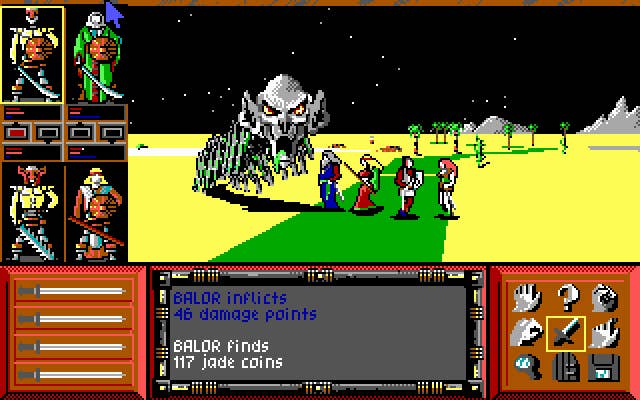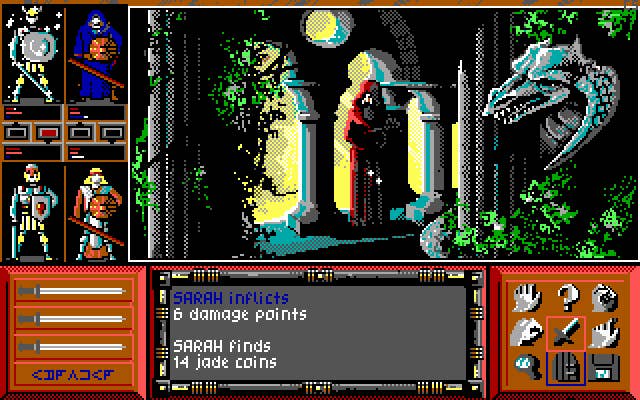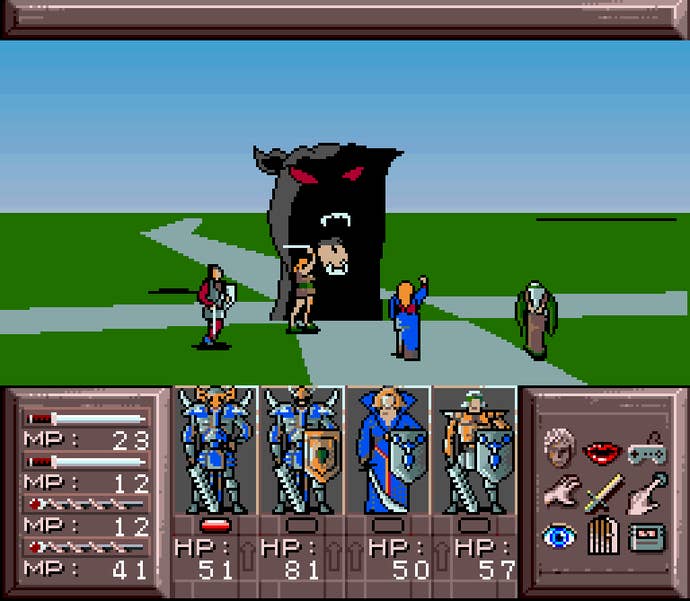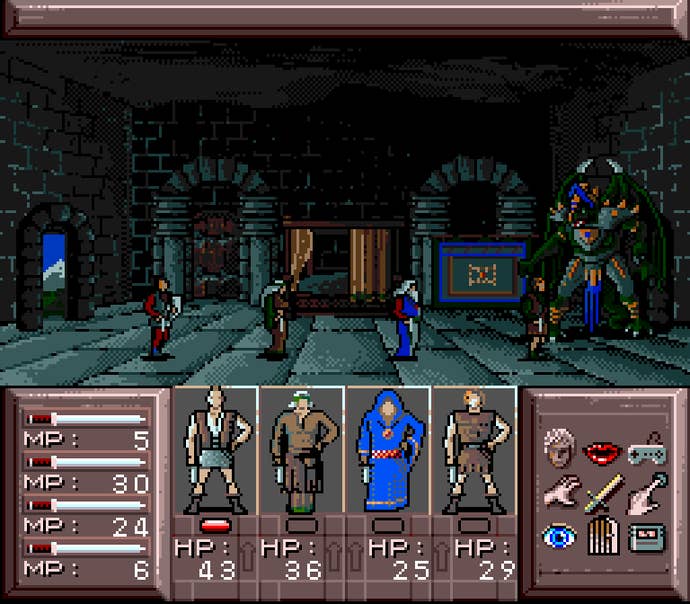Daily Classic: Drakkhen, an Ambitious RPG Collision Between East and West
A pioneering RPG on PCs and a weird aberration on Super NES, Drakkhen's legacy is vague yet fascinating.
This article first appeared on USgamer, a partner publication of VG247. Some content, such as this article, has been migrated to VG247 for posterity after USgamer's closure - but it has not been edited or further vetted by the VG247 team.
Given the divergent evolution of video role-playing games in Japan and America in the '80s, discussions of the genre's history invariably touch on the different outcomes of each region's take on the format.
It's easy enough to hold up something like Curse of the Azure Bonds against Japanese contemporaries like Mother or Dragon Quest IV to highlight the growing differences between the RPG output of those countries. Equally valuable, however, is looking into how one country would adapt the others' works — though by and large, those adaptations flowed in only one direction, west to east. On the relatively rare occasion Japanese RPGs made their way to the U.S. in the '80s and '90s, they generally changed only in the tone of the text — as in the way Dragon Quest abandoned its straightforward flavor in favor of Dragon Warrior's faux-Shakespearean "thees" and "thous" — or censored small details that might have been deemed offensive to American audiences.

When Western RPGs made their way to Japan, however, they often came hand-in-hand with fairly significant revisions, if only as a reflection of the difference in platform preference between the two audiences. Japanese gamers tended to role-play on consoles at least as much as on personal computers, while in America and Europe RPGs originated on PCs and only PCs. So when games like Advanced Dungeons & Dragons: Hillsfar or Ultima IV: Quest of the Avatar made their way into Japan, they had to be forced into a form suitable for play on a controller with a miniscule number of buttons. This rarely turned out well, especially with the NES/Famicom and its two-button controller.
And yet the demand for RPGs in Japan was sufficient that developers continued to import Western titles, prudent or not. By far one of the strangest adaptations to result from this trend was Infogrames' Drakkhen, which began life as a European PC game but is ultimately best known for its Super NES incarnation thanks to being the first RPG on the system. Drakkhen feels in every way a decidedly Western take on the genre, and its console adaptation by Kemco made for an awkward, ill-fitting role-playing attempt on a system whose RPGs would become legendary.
If anyone could have made Drakkhen work on Super NES, it would have been Kemco. The company had seen considerable success on NES by adapting Western PC games — specifically, ICOM's MacVenture graphical adventures — to console. Shadowgate, Uninvited, and Deja Vu could be unfriendly and needlessly opaque at times, but they still won over many fans with their interesting stories and the rich sense of place and atmosphere they created on Nintendo's humble 8-bit hardware. And while Drakkhen clearly fell into the RPG category, it bore many similarities to ICOM's graphical adventures, particularly in terms of its interface.
Unlike Shadowgate, however, Drakkhen didn't give players a finite, contained world to explore. On the contrary, it offered an early take on 3D open-world design — one of the very first, in fact, predating Bethesda's The Terminator by a year. Given its pioneering status, perhaps it's no real surprise that it took its open-world description quite seriously; after rolling their party's stats and classes, players begin in a green field with sparse trees and details dotting the landscape. A castle appears in the distance, beckoning epxlorers to investigate, but beyond that Drakkhen offers very little guidance in terms of direction or mechanics, even if you partake of the optional tutorial Kemco added for the console release.

As if its abstruse design weren't daunting enough for newcomers, Drakkhen seemingly reveled in surreality. Bizarre creatures would appear as you traveled across the landscape. At night, the stars themselves might begin to shift and twist, manifesting as a monster that would descend and attack. NPCs in fortresses and hideouts scattered across the land would share oblique snippets of information, but either by design or poor localization these tended to be confusing at best. The clues you would uncover along the way hinted at quests and puzzles that seemingly were never implemented within the game.
Drakkhen definitely feels like an RPG for experienced RPG fans, specifically those versed in the rules and expectations of computer RPGs. Unlike console role-playing experiences, Drakkhen offers no real guidance. It has no rails. It lacks convenient subdivisions of land to offer a hint that you're wandering into territory well beyond your party's means of survival, or even much in the way of pointers beyond a rudimentary in-game map. You're free to travel anywhere in the world from the outset, and you can easily encounter extremely high-level enemies with a novice party, a combination that practically guarantees a quick game over.

Despite its high expectations for responsible play, Drakkhen offers much that's compelling for those who survive its confusing opening hours. Even obscured by a haze of spotty localization, the lore of the world seems fairly detailed and well-developed, with the eponymous Drakkhen race — human/dragon hybrids — driving much of the plot. While the combat system tries unsuccessfully to marry action and menu-driven mechanics, the adventure game-like scenes feel much more solidly put together.
Most importantly, Drakkhen was mildly revolutionary for its time on a technological level. While many of its RPG predecessors had featured a similar free-roaming adventure, Drakkhen changed the camera angle from a top-down fixed perspective to a freely controlled point-of-view closer to the horizon, with scaling sprites for geographic features. The style bore a strong resemblance to Sega's "super scaler" System 16 arcade games, but with a full 360 degrees of movement rather than forced forward scrolling. The first-person 3D perspective had been a fixture of the genre since at least the dungeon portions of the original Ultima, but Drakkhen's world didn't appear as rigid wireframe hallways; it presented seemingly endless vistas in all directions.

The fake 3D visuals made it a perfect match for the Super NES, whose "Mode 7" graphical format was ideally suited for Drakkhen's vast planar landscape. In fact, despite being something of an awkward fit with the controller-based interface and the expected play mechanics of the Super NES, Drakkhen made enough of an impression on that platform to inspire a Super NES-only sequel. Sadly, while that sequel, Dragon View, presented console RPG fans with an adventure more to their expectations, it lacked the decidedly European weirdness of Drakkhen. By the time Dragon View launched in 1994, the Super NES/Super Famicom offered a vibrant selection of RPGs from which to choose, and Dragon View didn't quite cut it.
In its original PC incarnation, though, Drakkhen paved the way for countless games to come. Bethesda would follow up The Terminator with 1994's The Elder Scrolls: Arena, and Ultima would make a foray into free-roaming 3D exploration in 1992 with Ultima Underworld. Today, open-world game design has become practically de rigueur; if an action or adventure game doesn't subscribe to the rules of guided, cinematic presentation, it almost inevitably goes for a free-roaming style.
Few people seem to remember Drakkhen today, except as "that weird SNES RPG with the giant dog heads," but that's progress for you. Sometimes the road to get there can be a bit bumpy.
